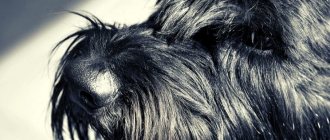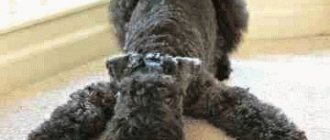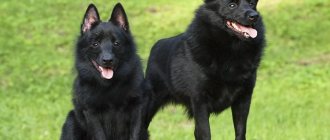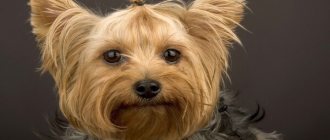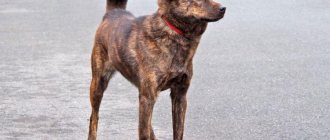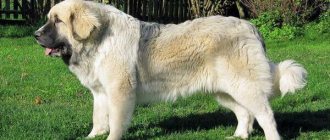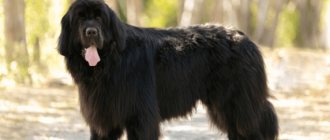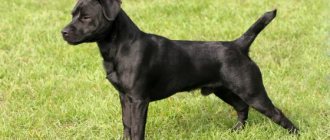Home / Breeds / Dog grooming / / Miniature Schnauzer
The Miniature Schnauzer is a German guard dog. Like many other dogs, the origins of the Miniature Schnauzer are lost in the mists of time. It is believed that the ancestor of the Miniature Schnauzer was turf dogs that lived about five thousand years ago. The breed became famous only in 1895, when the Pinscher-Schnauzer Club began its work. It is worth noting that the Miniature Schnauzer became the basis for the creation of many other schnauzer breeds, for example, the Giant Schnauzer. Nowadays, the dog has become a typical companion dog. However, given the opportunity, a dog can stand up for itself and its owner.
Features of the Schnauzer's coat
Dogs of this breed have very coarse hair with a dense undercoat. Nature dictates that all pets shed several times a year, and the Mittel is no exception. However, dead hairs do not fall out of the animal's hair, remaining in place and irritating the pet's skin.
Important! If loose hair is not removed promptly, it can lead to serious skin irritation, scratching and inflammation.
This causes a lot of inconvenience for dogs. For healthy and proper care of your pet, you must take him to an appointment with a groomer. This is a special dog groomer who can help and carry out the trimming procedure as quickly and painlessly as possible.
When is the best time to trim?
The Miniature Schnauzer's coat should be trimmed starting from 4 months of age. It has a number of advantages - first of all, the density of the coat, which protects the dog from dirt, snow, wind, rain, as well as from the claws and teeth of other animals. It is also the silkiness and shine of coarse wool. It does not fall off and holds its shape well after cutting. First, the specialist examines the dog and finds out whether the animal’s hair loss cycle has completed. Usually when this happens, the fur begins to tangle and become ruffled. Then, using special tools, the specialist plucks out unnecessary dead hair.
Rules of care
It is noteworthy that the coat of schnauzers, if cut with a regular dog clipper, loses its quality and ceases to meet the standard approved by influential canine communities.
In particular wool:
- becomes thinner;
- changes color;
- becomes softer;
- thins out.
All this cannot but affect external data. If the dog has a show career and is expected to continue to participate in breeding, such care is unacceptable. Even attempts to remove dead hair on your own can lead to loss of wool quality.
A haircut
Caring for schnauzers is quite difficult. Here, combined methods are used to give the dog a show look. Haircuts with scissors and clippers are used, but only in strictly defined places.
Important! The haircut must be done against the pet's fur. Every groomer should know this.
A haircut with a clipper is carried out in the area of the dog’s neck and “pants”. Use scissors to straighten the fur on the animal's face, legs and belly. The rest of the coat is subjected to a trimming procedure. Each groomer himself chooses the number of procedures for this operation. Not all dogs can handle the lengthy process at one time. Often, owners have to bring their pet to the salon several times in a row.
Trimming
Trimming is the plucking out of dead fur. Be sure to do this according to hair growth. For this, a small special knife is used, which is clamped with the master’s right hand. The left hand holds the skin on the treated area.
Important! After treatment, the dog's skin remains almost bare. During the cold season, you need to take care of warm clothes so that the dog does not freeze.
It should be noted that pinching is very unpleasant for the pet and the procedure can become a real test for the master and the schnauzer. But if it is carried out regularly, from about 6 to 8 months of age, the puppy should get used to it over time.
How will be correct?
Grooming is carried out in three stages. The set of tools required for the procedure consists of:
- trimming knife;
- metal comb with non-sharp teeth;
- hairdressing scissors;
- trimmers;
- brushes for cleaning dogs from hair residues.
Trimming
During processing, most of the Schnauzer's trimmed , that is, pinched. The first trimming is carried out at the age of four months, then the dog needs to be treated 2-3 times a year, depending on the rate of hair growth (it is individual for each individual).
When trimming, the groomer starts at the head and works his way down. The back of the head, the back and sides of the neck, the body of the dog, the sides (decorating strands remain below, which are then trimmed with scissors), the front legs to the elbows, the hind legs to the hocks are completely worked out. The upper part of the tail is also trimmed.
Trimming is carried out according to the growth of hairs, plucking them with sharp jerks. When pinching, small bunches are grabbed as close to the roots as possible. If you plan to show your dog, you need to make sure that the guard hair has time to grow before the show, that is, grooming is best done 6-8 weeks before the date of the show. After a haircut, the Miniature Schnauzer will remain almost naked, so you should think about buying overalls for walking if it is not summer outside.
Haircut with clipper
Unlike trimming , machine cutting of a Miniature Schnauzer is done against the hair growth.
Ideally, all parts of the Schnauzer's body that are not covered with decorative hair should be plucked. But in practice, in some places, trimming causes pain due to the high sensitivity of certain areas of the dog’s body. It is not at all necessary to subject your pet to a painful procedure - this is especially true for dogs that are kept as pets, not pursuing a show career. You can remove excess wool with a machine:
- in the genital area and under the tail;
- on the temples;
- on the throat;
- on the ears;
- on the stomach.
Decorating wool
the Miniature Schnauzer's body that form such a familiar and characteristic silhouette are modeled with clipping . The beard, mustache and eyebrows should remain on the muzzle. Tufts of hair at the inner corners of the eyes and sideburns are removed. The long hair on the body is neatly trimmed, a “skirt” is formed at the back, which smoothly transitions into the feathering on the hind legs. The hair between the dog's toes is trimmed and the paws are shaped.
It is important that the transitions from long decorative coat to short be smooth - for this, when cutting, you need to look at the dog from different angles and comb the strands as they would lie naturally. It is useful to check what a schnauzer looks like in motion - this allows you to understand which features are best emphasized and which ones to suppress.
Hiding the shortcomings, highlighting the advantages
Every dog has strengths and weaknesses, and proper grooming will help show it off in a favorable light. Most of the techniques are based on trimming in several stages: some areas of the body are plucked in advance, so that by the time of the main treatment the hair in these places is already grown. As a result, the shortcomings are leveled out by the difference in hair length.
- If the hock joints are too close together, it is worth trimming the hair between them as much as possible, leaving more on the outside.
- If the docked tail is set too high, the defect is hidden by earlier treatment of the area at its base.
- If the withers are not sufficiently pronounced, they are “trimmed” in a similar way: the hair on the back of the neck is trimmed about a month before everything else.
- A sunken belly is corrected with decorative wool.
the Miniature Schnauzer's will need to be trimmed 10-14 days before the show date .
Adviсe
Beginners or processing with trimmers at home can end very badly. A carelessly or unevenly cut “skirt”, too bare areas of the body and non-compliance with the timing and seasonality of procedures are just the most common mistakes.
Experienced Schnauzer owners note that the best solution is to go to a professional groomer at a dog salon. Only an experienced hairdresser will be able to do a competent haircut and provide the animal with an attractive appearance.
To prepare for exhibitions and competitions, there is a special range of services that includes all the necessary procedures. The dog is fully prepared to be shown to experts, taking into account all the important nuances in the pet’s appearance.
Similar articles
Grooming a Miniature Schnauzer at home
Inviting a professional groomer is the best solution. Being in a home environment, the dog will not be nervous and will endure the entire grooming process much more calmly. Also, a specialist’s visit to your home will save the owner from the need to take the dog to the salon, which will significantly reduce the time for carrying out all procedures. And there may be a lot of them. First of all, the dog needs to be washed. This can be done in advance by the owner himself, or maybe by an invited master, using your bathroom for this. The master will bring all shampoos and hair care products with him. The Miniature Schnauzer is a dog used in many countries around the world as a service dog. Under no circumstances should you forget about this. It is advisable to establish contact between the master and the animal, but if the dog still shows signs of nervousness or aggression, it is necessary to wear a muzzle. An experienced groomer will never start cutting without asking the owner about the dog’s personality traits. The Schnauzer's coat has a very hard structure; this is one of the obligatory characteristics of the breed. The main task of the master is to improve the appearance of the dog and remove dead hair. This is achieved using trimming. The procedure is carried out using a special stripping knife. The whole process can take several hours, so you should think in advance where the groomer and your pet will be located so that they are comfortable. The dog's coat may require additional care - for example, if it is matted and tangled. In this case, the groomer will have more work - the dog will first have to be combed and tangles cut out. The final stage will be the final formation of the haircut using scissors. The long woolen fringes that adorn the Miniature Schnauzer's paws, as well as the so-called “skirt,” are trimmed and shaped at the end of the grooming procedure. The beard and bangs are also cut after trimming.
Character of the Miniature Schnauzer
We can say with confidence that absolutely all animals of this breed are multidisciplinary. They are excellent companions, working dogs, service dogs, and are actively used in search and rescue teams. In addition, the average schnauzer is an excellent watchman who guards the home territory entrusted to him, trying not to let strangers into it.
These are smart, cunning, dexterous and very smart dogs. They are happy to learn commands with their owner, performing them almost the first time. Constant learning is not required - the dog, having completed the exercise once, can easily repeat it at any time.
This is a very active breed, not only in terms of physical work, but also in expressing feelings. The pet always happily greets all family members, attracts attention, invites you to play and run for a walk. Schnauzers love children and patiently tolerate various pranks in their direction. But they won’t tolerate rude behavior, although they won’t snap and growl at the kids, but will simply go out of sight.
They treat strangers in the house with suspicion, but if they see that the owner is actively communicating with them, they may come up to meet them. But even after this they will not let you out of sight, trying to keep everything under control. The character of the Miniature Schnauzer makes it a unique dog, capable of displaying the widest range of feelings and emotions.
Health and life expectancy
Mittels live from 12 to 14 years . The following diseases are observed that representatives of this breed are prone to:
- Pancreatitis
- Oncology
- Hip dysplasia
- Cataract
- Cystitis
- Atopy
- Hypothyroidism
- Unilateral cryptorchidism
These diseases are not widespread. Miniature Schnauzers, as servants, must withstand physical activity and be resistant to stress.
History of the Miniature Schnauzer breed
According to one version, the Germans in the 18th century used Schnauzers as hunters of small rodent pests . In other sources there are descriptions that representatives of this breed accompanied humans several centuries ago.
This is how the painters Rembrandt and Reynolds depicted dogs on their canvases that are very reminiscent of modern mittels. This suggests that they were favorites of the nobility of those times.
"Night Watch", 1642, Remborandt Harmens van Rijn. In the lower right corner of the canvas there is a dog that looks like a miniature schnauzer.
A Swiss zoologist named Studer named the supposed ancestor of the Miniature Schnauzer - the turf dog . According to other experts, the breed owes its appearance to the crossing of poodles, wire-haired pinschers and Wolfspitz.
The breed has an informal name - rat catchers. The name Schnauzer is tied to its appearance and means " beard ".
In the history of the breed, 1880 was the first year when breeders officially began breeding Mittels. The First World War opened up new functions in the Miniature Schnauzer. They retrained as ambulance dogs and communications assistants.
The “pepper and salt” coloring finally took hold during World War II. The pedigree coat of the Miniature Schnauzer is the merit of man; with natural selection, the appearance of this type is almost impossible.
Appearance of the Miniature Schnauzer
General impression
Representatives of this breed are distinguished by wide, strong bones, a square skull and coarse hair. The dogs are quite stocky; tall-legged representatives are not found. From the photo, it is a little difficult to distinguish miniature schnauzers from their smaller relatives - miniature schnauzers.
Head
The bones of the skull are strong, massive, and it itself has an oblong shape. The occipital protuberance is visible to the naked eye. The transition from forehead to muzzle is sharp. The forehead is flat, there are no wrinkles. The muzzle is wedge-shaped with a straight line at the back of the nose.
The nose is large, only black is allowed. The lips are black, close tightly together and adhere to the teeth. The jaws are strong, large, and have a standard scissor bite. Mittels have a well-developed dental system with 42 large teeth.
The eyes are dark, oval-shaped, and deep-set. The ears are triangular in shape, hang on cartilage, the inner edges touch the cheekbone, docking is allowed.
Neck
The neck of representatives of this breed is strong, has well-developed muscles and is of medium length. A smooth, neat transition to the withers is noticeable.
Torso
The body is squat, the format is squared. The topline is slightly sloping from the height of the withers to the croup, forming a slight slope. The withers are the highest zone. The back is strong, short, muscular. The chest is oval, deep set.
The lowest point of the chest should be at the level of the dog's elbows. The lower back is muscular, shortened. Dome shape is not allowed. The croup is rounded, smoothly extending to the base of the tail. The belly line is smooth and curved.
Forelegs
The paws are strong, straight, when viewed from the front, completely parallel to each other, the muscles are well defined. The setting is wide enough. The scapula bones are adjacent to the body. The angle is 95-105 degrees. Pasterns are strong, stable, slightly springy.
Hind limbs
When viewed from behind, the paws are parallel to each other and have neither a narrow nor a wide set. Knees point straight. When the animal is in the breed stance, they are not expressed. The lower legs are sinewy, strong, elastic. The hock joints have significantly pronounced angles, especially noticeable when standing. Fingers are small. The pads and claws are black.
Tail
The natural tail has a saber or crescent shape. The hare's position, when he lies flat on his back towards the head, is considered a significant fault. Docking at the level of 2-3 caudal vertebrae is not prohibited.
Movements
Schnauzers, despite their square format, have natural beautiful, one might even say, refined movements. The step is free, sweeping, active, there is no stiffness. Paw pushes are elastic, springy.
Wool
These animals belong to the category of wire-haired dogs. The coat is rough to the touch, adheres tightly to the thick undercoat, and lacks elasticity. The length is average. The hair covering the head is shorter than that on the body. The beard and eyebrows are also tough. Mittels require regular trimming, which consists of plucking out old hair and helps the dog grow new hair. This is due to the fact that pets completely lack independent molting. Shearing is prohibited; it spoils the quality of the wool, making it thinner.
Color
There are only two acceptable colors of the Schnauzer according to the breed standard:
- Classic black, when both the coat and undercoat have the same uniform shade. In this case, the puppies can be brown or dark gray, and after a while they change color and become black;
- “Pepper and salt” is cultivated and has several shades – from light silver to dark steel. In this case, the dog should have a black darkened mask that favorably emphasizes the shape of the head.
Size
The height of miniature schnauzers, both males and females, at the withers should be no lower than 40 cm and not exceed 45 cm. Optimal height is 42-43 cm. The weight of the Miniature Schnauzer ranges from 14 to 20 kg.
Any deviation from the official breed standard may reduce the show score. This also applies to the size of the Miniature Schnauzer.
Miniature Schnauzer trimming at home
Trimming a Miniature Schnauzer at home is quite quick and easy. For a dog, this procedure is completely painless. And if it is carried out from 4 months of age, then some Schnauzers get so used to it that they fall asleep during the procedure. Create a hairstyle characteristic of the Schnauzer breed and wash it. The benefit of trimming at home is that the animal will experience less stress in a familiar place, close to the owner. And the owner will be calmer, because he can watch how the master works and consult with him. The dog behaves much calmer in such a situation, which gives the specialist the opportunity to do his job faster and better.
